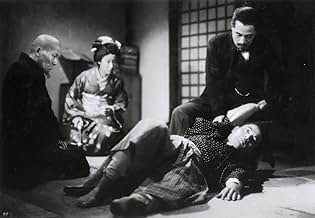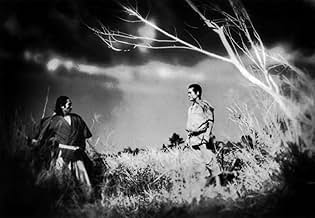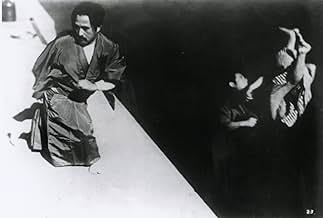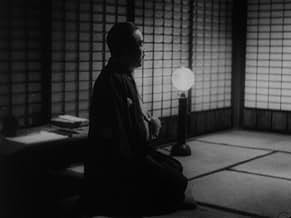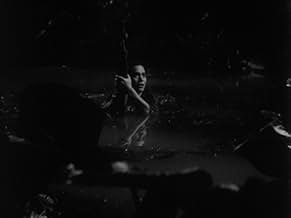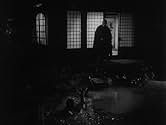Sugata, um jovem, luta para aprender o significado do judô e, ao fazê-lo, aprende algo sobre o significado da vida.Sugata, um jovem, luta para aprender o significado do judô e, ao fazê-lo, aprende algo sobre o significado da vida.Sugata, um jovem, luta para aprender o significado do judô e, ao fazê-lo, aprende algo sobre o significado da vida.
- Direção
- Roteiristas
- Artistas
- Hatta
- (as Michisaburo Segawa)
- Monma's pupil
- (não creditado)
- Direção
- Roteiristas
- Elenco e equipe completos
- Produção, bilheteria e muito mais no IMDbPro
Avaliações em destaque
Based on a best-selling novel, Sugata Sanshiro established the reputation of Kurosawa, and made him a prominent figure in the filmmaking business. Though it's far from being a genuine masterpiece, the film still shows the director's steady hand and is the admirable proof of his awe-inspiring versatility.
To become the master of martial arts is an uneasy task, and Sanshiro learns the lesson in the first minutes of the picture. Trying to join a clan of Jujitsu fanatics, he quickly realizes that they're just a bunch of up to no good coxcombs. Seeing how easily Yano (Denjirô Ôkôchi), the originator and master of Judo, defeated the group, Sanshiro decides to become his student. To become a proficient Judo technician the young, strong-willed, yet somehow reckless Sugata must overcome many of his weaknesses and find out the meaning of a warrior's way, thus learning the true meaning of life. The student, struggling to accustom himself to the situation, is constantly tested by his master, in many more or less laborious ways. And when the time comes, Sanshiro is finally able to take part in tournaments, in order to prove his indisputable technique and unrestrained power. On his way Sanshiro meets a mysterious, elegant, devilish man by the name of Hagaki (Ryûnosuke Tsukigata), who's like a shadow that's been following Sugata everywhere that he goes. Ironically so, the man - with his familiar look and specifically evil attitude - comes as a typical dark character, taken straight out of a superhero movie. In the film's most climatic and disquieting sequence, the two rivals participate in a duel that will determine who's the strongest living martial artist.
For all the lovers of Japanese culture, and for all the adepts of Asian martial arts, Sugata Sanshiro will definitely be a worthy film experience. For the rest it might be an insightful, valuable, and well-crafted period drama that's not only full of perfectly choreographed action scenes, but also full of humane qualities that prove to have an authentic meaning even in the modern times.
There are little notes to take for Kurosawa fans, little things that will give many a grin and even a laugh at what pops up: the classic "wipes" as means of scene transitions; the usage of slow-motion during an action/fight sequence, in this case at the end of a fight as the opponent conks out and the flag (this part in slow-motion) falls to the ground; Takashi Shimura, who appeared in more Kurosawa films than Mifune, as one of Sugata's opponents, who's a tough cookie but a fair fight who at the end gives Sugata praise as a great fighter; symbolism in usage of the sky, flowers, and other Earthly means as a way to communicate the environment of a scene, and a specific nature about it, as much as the characters in it. All the same, this is not to say that Sanshiro Sugata is exactly a masterwork right off the bat for the 32 year old filmmaker; the use of certain symbols, like when Sugata is in the mucky pond trying to have his own form of penance and snaps out of it once seeing a flower right in front of his face, isn't really as effective as intended and comes off as more of a cliché than anything else. The subplot with Sugata and the daughter is undercooked as romance, even as brief as it is. And the fact that the film now stands as missing 17 minutes is a hindrance; one has to comment on what remains as opposed to what could have been a complete work from Kurosawa (not as detrimental as the Idiot, but still bothersome all the same as in the title-card transitions).
But as an act of passionate action film-making, it stands its ground some 60+ years later in containing some intense scenes involving Sugata's training (I liked seeing Sugata coming face to face with a man who wants to challenge his boss, and dressed in more Western garb than anyone else in the film), and more specifically the actual fight scenes. While its a given that Kurosawa is a pro at getting down stubborn men- and professional traditionalist men for that matter- getting down and dirty and violent, it's impressive in hindsight from the rest of his career that he could add tension just by tilting the camera up during the street-fight, or in staying on the faces of the fighters, and numerous reaction shots, during the fights in the arena area. The Shimura fight especially has an aura of being as thrilling as a modern fight sequence, with aforementioned humanity coming through with every pummel and thrust and toss-up of one character over another. This all leads up to the climax, which is not only a highlight of the film but a highlight in the history of classic Japanese action sequences, as we see Kurosawa already relying on the sky, the grass pushed and pulled by wind, and the compassion of the others around the two opponents (the old man and the girl) as a fight to the death, seen mostly out of sight through the grass, proceeds intensely more due to the intent and emotion of the characters than traditional stunts and fast-pace editing.
Sanshiro Sugata is a worthy production in the cinematic cannon of Kurosawa, acting as a very good stand-alone effort for genre fans while speaking to his practically intuitive cinematic strengths at controlling the pace of a scene and meaning via certain visual cues and enjoyable performances garnered by the pro actors. It does show some of its age, and along with the cuts made in the only version available today (in a print, by the way, that is rather horrid considering who the director is) it had to face some given restrictions due to Japan's censorship laws, but it's also a cunning display of a debut showcasing the talents of a confident director in a film that was meant to be seen by a mass audience, if only for diversion during the war.
Você sabia?
- CuriosidadesWhen asked about his experience filming his debut movie, Akira Kurosawa said "I simply enjoyed it. I went to sleep each night looking forward eagerly to the next day's shooting, and there was absolutely nothing painful in the experience... the whole task was carried out with a feeling of ease."
- Citações
Sanshiro Sugata: The spirits of heaven and earth congregate in our nation of gods. For us they have built Mt. Fuji that towers for eternity. For us they have brought water to flow around our islands. For us they have created the beauty of cherry blossoms...
[he stops and remembers Sayo]
Buddhist Priest: [hits Sanshiro on the head] Idiot! This is an important match. What the hell are you thinking?
Sanshiro Sugata: I can't do it. I can't win.
Buddhist Priest: What? Are you afraid of Hansuke Murai?
Sanshiro Sugata: No. Someone stands between him and me.
Buddhist Priest: Who?
Sanshiro Sugata: His daughter.
Buddhist Priest: You love her?
Sanshiro Sugata: No. It's not that. Priest, I saw her praying selflessly for her father. It was beautiful and I was touched. That's the problem. How can I overcome it?
Buddhist Priest: Stupid! Be pure and innocent like her.
Sanshiro Sugata: I can't.
Buddhist Priest: You can. You once were.
Sanshiro Sugata: When?
Buddhist Priest: [pointing to the pond] Sanshiro Sugata found new life there. Have you forgotten? What is your life, Sanshiro?
- Versões alternativasAlthough originally released in Japan at 97 minutes, it was re-edited and re-released in Japan in 1952 at 80 minutes. This 80-minute version is all that is currently available, and it includes some slight changes in the film's structure as well as its running time.
- ConexõesFeatured in Kurosawa: The Last Emperor (1999)
Principais escolhas
- How long is Sanshiro Sugata?Fornecido pela Alexa
Detalhes
- Tempo de duração1 hora 19 minutos
- Cor
- Mixagem de som
- Proporção
- 1.37 : 1
Contribua para esta página


